Shep Hyken's Blog, page 86
April 23, 2021
How to Use Social Media as a Customer Service Channel (+ Examples from Brands)
This week we feature an article by Devin Pickell, a Growth Marketer at Nextiva. He shares customer service best practices that successful brands use to help their customers on social media.
Businesses have been using social media for years now to publish content, engage with their audiences, advertise their products, and stand up for social causes.
Another intuitive and frankly underutilized way brands can use social media is for addressing customer service inquiries.
In this article, we’ll discuss why your brand should consider upping its customer service game on social media and take a look at some brands that do it well.
Why use social media as a customer service channel?Data tells us that one-third of U.S. consumers have used social media to complain about a brand. If you don’t bother to respond and let complaints go unresolved, this could have a negative impact on how others view your brand, even if they’ve never interacted with your business before.
You don’t want complaints to sit on a public forum like social media, which is why your social media person should either have the autonomy to reply to complaints or be given a strategy for addressing complaints.
Even something as simple as taking the chat off the public forum and into direct messages (DMs) can do wonders for the customer experience, see the example below of how this is done:
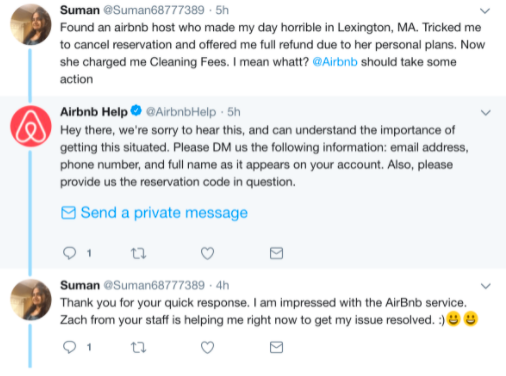
Another reason to use social media as a customer service channel is that traditional channels like inbound call centers and email, while still effective, are being slowly outpaced by social media. According to a report by Conversocial, 54% of customers prefer to use social media for getting support conversations started.
If your brand has no plans to adopt social media for customer service, you may be missing out on key interactions with your customers.
If your brand is open to using social media for customer service or looking to improve your social support strategy, here are some of the top examples from brands that have mastered social media.
5 brand examples of great customer service on social mediaTake a page out of one of these brand’s playbooks if you’re looking to embrace social media as a customer service channel.
Best Buy
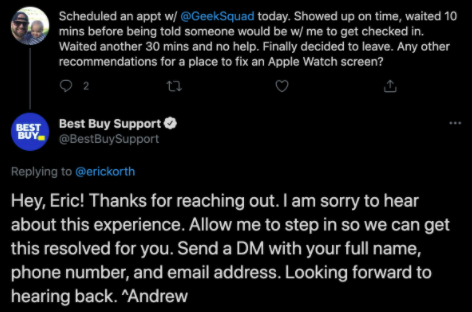
What they did right: With more than 1,2000 stores worldwide and an e-commerce site with millions of monthly visitors, it made sense that Best Buy created a separate account solely for customer support. If you have a wide-reaching brand, it could help to create a separate account to hone in on those customer inquiries.
This timely response also helped Best Buy reel in a customer from using a competitive service. Adding the social support person’s name at the end of the Tweet made this feel response feel more personalized.
Semrush
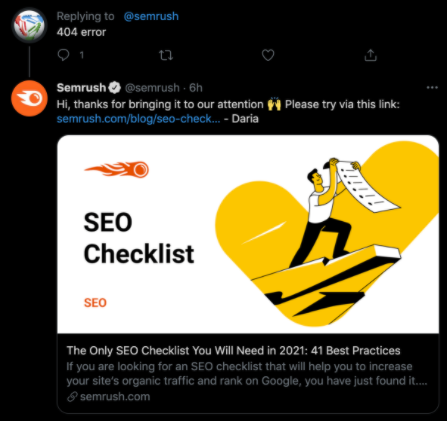
What they did right: Who said B2B brands can’t embrace social media for customer support? Here is a recent example of Semrush interacting with followers regarding a bunch of links on their website that were returning a 404 error.
Even with their website down, Semrush took the time to respond to each person in their replies with a live URL. Great customer service isn’t always the fastest, but it is the most thorough and caring in regards to the customer.
Zappos
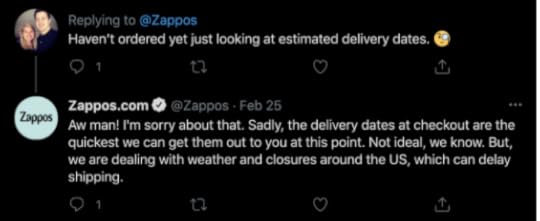
What they did right: It would be hard to write a “great customer service” article without mentioning Zappos, as quality service is literally part of the brand’s mantra. Here, we see Zappos have a back-and-forth interaction with a customer regarding a pair of shoes that would be experiencing delayed shipping.
Zappos’ social media person decided it was best to be completely transparent about the shipping delays instead of ignoring the customer or giving a false expectation. Nowadays transparency is the name of the game. According to Sprout Social, 86% of U.S. consumers say brand transparency is more important now than ever before.
Shopify

What they did right: We mentioned earlier that Semrush was a good example of being thorough and replying to each individual customer with a website issue. Shopify is another brand that exemplifies thoroughness when it comes to customer service.
Here we see a customer is struggling with sales tax being applied in their checkout system. Peter, the Shopify representative, not only provided product screenshots but a full thread of helpful tips and explanations. This is the type of product knowledge you should expect from your support team.
Macy’s
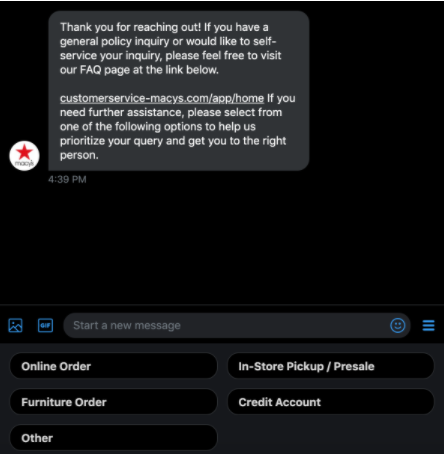
What they did right: The final brand example on this list isn’t a customer service interaction between two humans. Instead, it comes from Macy’s, a brand that utilizes customer service automation on its social media in the form of a chatbot.
Basically, a user clicks a button regarding their inquiry and is then lead down a chat flow. This allows the customer to (hopefully) resolve the issue themselves, but in case the issue isn’t resolved, they’re allowed to escalate to a human representative.
Self-service customer support is trending upwards. Research from Harvard Business Review revealed that 8 in 10 customers are open to resolving an issue themselves before reaching out to a brand.
Time to get socialWith more people taking to social media to seek support from brands, now is the time to consider implementing it into your customer service strategy.
Meet your customers on the channels they enjoy using and make the process of getting support as painless as possible. By using some of the tips from the brands I’ve listed above, you’ll have no issue satisfying your customers on social media.
Devin Pickell is a Growth Marketer at Nextiva. He combines his skills in content marketing, SEO, data analysis, and marketing strategy to meet customers at the right moment in their journey.
F
 or more articles from Shep Hyken and his guest contributors go to customerserviceblog.com.
or more articles from Shep Hyken and his guest contributors go to customerserviceblog.com.
Read Shep’s latest Forbes article: Leaders Share 10 Ways To Manage A Remote Workforce
The post How to Use Social Media as a Customer Service Channel (+ Examples from Brands) appeared first on Shep Hyken.
April 21, 2021
There Is No Excuse to Not Respond to a Customer
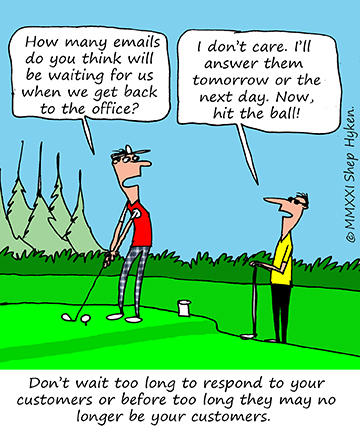
Let me put it to you in the simplest terms possible. When your customer calls, emails or texts you, you must respond. That is unless you don’t care if they ever do business with you again.
One of our subscribers to The Shepard Letter, Andy Saks, owner of Spark Presentations and professional corporate presenter, sent in a story worth sharing. (By the way, if you’ve got an amazing – or horrific – customer service story, send it over. I collect them and may include them in one of my articles or videos.) Here’s a short version of what happened.
Andy was interested in buying more life insurance, so he emailed the agent he had done business with in the past. He didn’t get a reply, so after several days he called the agent’s office. He explained to the receptionist that he’d reached out to him and nobody had responded. Her explanation was, “He was out that day and has been in a lot of meetings.”
Andy asked me, “Am I out of touch with reality? Should I have expected a quicker response? After all, I’m a client, a warm lead for new business, and I represent income to him. If he can’t respond the same day, if not the same hour or minute, then don’t you think someone from his organization should have been tasked with responding for him, rather than leaving me hanging for several days?”
It’s not that Andy is impatient. He mentioned that an auto-response from his email would have been acceptable for the day he was out. But to keep him waiting for days and forcing him to call was, for Andy, unacceptable. Especially with the excuse, he was given. In effect, he was chasing the agent down to give him more business. Usually, it’s the other way around.
Here’s the lesson: Fast response builds trust and confidence, shows you care and is respectful. It’s just the right thing to do. A slow response – or no response – sends the opposite messages and will work against you for future business. At best, you’ll have to work hard to overcome that Moment of Misery. At worst, your customer will move on and find someone who is more responsive.
There are two considerations for determining the speed of response times. First, decide what your minimum acceptable standards are for responding to calls, emails, and any other type of communication from your customers. It may be the same business day, by the next business day, or something much shorter. And two, determine the optimal best response time. One that would impress your customers.
Andy Saks shared his thoughts on this. “I’ve made quick responses a key tenet of my own business. I’ve found that responding within an hour to a lead shows, through my actions, that I care about them, distinguishes me immediately from other options, and helps build the trust that leads to business.”
It doesn’t matter if you’re in sales, service, or any other part of your organization, something as easy as a quick response time has so many benefits that add to the customer experience.
Shep Hyken is a customer service expert, keynote speaker, and New York Times, bestselling business author. For information, contact 314-692-2200 or www.hyken.com. For information on The Customer Focus customer service training programs, go to www.thecustomerfocus.com. Follow on Twitter: @Hyken
customer service training programs, go to www.thecustomerfocus.com. Follow on Twitter: @Hyken
(Copyright © MMXXI, Shep Hyken)
The post There Is No Excuse to Not Respond to a Customer appeared first on Shep Hyken.
April 20, 2021
Amazing Business Radio: Jeff Nicholson
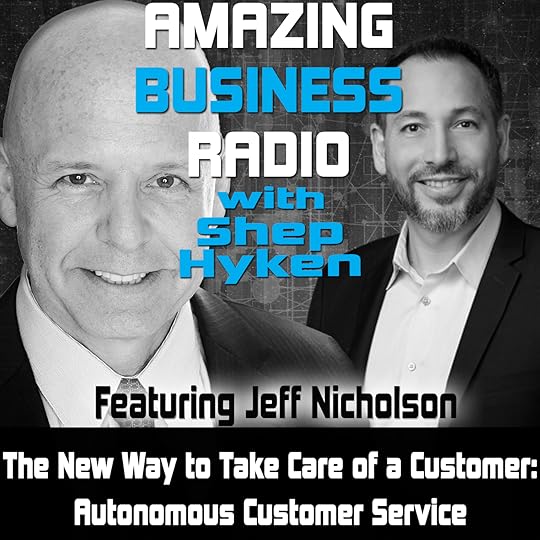 The New Way to Take Care of a Customer: Autonomous Customer ServiceHow Autonomous Customer Service impacts the Customer Journey
The New Way to Take Care of a Customer: Autonomous Customer ServiceHow Autonomous Customer Service impacts the Customer JourneyShep Hyken interviews Jeff Nicholson, Global Head CRM Product Marketing of Pegasystems. They discuss how autonomous customer service impacts the company, its employees, and their customers.







Top Takeaways:
56% of consumers go to a company’s website before they call customer service. In many cases, this can be a missed opportunity to contain and resolve a customer’s concern.Almost half of the consumers believe that self-service is more convenient. 82% say that they are willing to use self-service but 46% don’t expect it to work.Right now, most self-service channels are focused on information about the company and its products instead of the customer journey.Of the customers who tried self-service, 50% still end up with the live agent. Only 33% are satisfied with self-service.Autonomous customer service allows the complete ability to focus on the customer journey regardless of the channel.Autonomous customer service can be simple to implement. There are more sophisticated setups, but it can be as simple as setting business rules to monitor data, initiate outreaches based on changes in the data, and track performance.Autonomous customer service gives companies the opportunity to avert and resolve most customer inquiries without agent interaction. This gives companies a high cost-benefit while increasing the level of customer service.In 5 years, there will still be a need for human customer service agents, but the nature of their work would be more meaningful as mundane inquiries will be handled through autonomous capabilities.Organize around the customer journey and activate that across all channels.Quotes:
“It shouldn’t matter how or where the customer seeks their service resolution. You should be able to rise to the challenge and meet them anywhere they want.”
“Autonomous customer service is everywhere we look today. It is both responsive and proactive”
“The autonomous customer service journey is not always about customers reaching out to you. Sometimes, you reach out to them before they contact you.”
About:
Jeff Nicholson is the Global Head of CRM Product Marketing for Pegasystems, where he leads the company’s CRM market vision and strategy.
Shep Hyken is a customer service and experience expert, New York Times bestselling author, award-winning keynote speaker, and your host of Amazing Business Radio.
This episode of Amazing Business Radio with Shep Hyken answers the following questions … and more:
What is Autonomous Customer Service? What the difference between preemptive service and proactive service? Is Autonomous Customer Service worth it? Will AI replace customer service agents? Does Autonomous Customer Service take away the need for human customer service agents?The post Amazing Business Radio: Jeff Nicholson appeared first on Shep Hyken.
April 19, 2021
5 Top Customer Service Articles For the Week of April 19, 2021
Each week I read a number of customer service and customer experience articles from various resources. Here are my top five picks from last week. I have added my comment about each article and would like to hear what you think too.
10 Statistics (and Action Items) to Inspire Your Next Steps in Customer Service Training by Veronica Krieg
(Sharpen) Here are 10 statistics to inspire your customer service training, along with actionable tips to take back your time and put it toward high-value work, like coaching your team.
My comment: Customer service training doesn’t cost. It pays. Here are ten stats to inspire your customer service training from our friends at Sharpen. Here’s the first one to get you motivated. There’s a three-dollar return for every one dollar the company spends on a better customer experience.
Want to Make Retail Customers Happy? Give Them a ‘Wow’ Experience by Thomas Robertson and Paula Courtney
(Knowledge@Wharton) Wharton’s Thomas Robertson and Paula Courtney from Verde Group talk about a new study showing how retailers benefit by delivering a great customer experience.
My comment: I’m often asked if buying habits have changed after a year of COVID-19. At the beginning of the pandemic, customers were confused, concerned, and scared. There was definitely a sign of change. But after a year of living through the pandemic, customers’ expectations have gone back to the way they used to be. Their expectations haven’t changed much. In other words, retailers can’t use the pandemic as an excuse for poor service.
Creating Content For Employee Experience & Customer Experience by Vivek Nanda
(Business 2 Community) This article focuses on how your organization’s content influences customer experience (CX) and employee experience (EX).
My comment: Many companies recognize the value of content marketing – sending relevant information (content) to their customers. This article suggests content marketing should also be used by employees inside the organization. Give employees good information that is useful to their jobs, and they will reciprocate by delivering a better experience to the customer.
In the Digital and Customer Experience World, there are two lives: Before and After COVID-19. Is your company ready? by Ricardo Saltz Gulko
(Eglobalis) This article will help you as a leader realign your organization to reignite its ability to deliver a much better experience for your customers, partners, and employees. It will also define what it means to be a truly customer-centric company.
My comment: Ricardo Saltz Gulko has written another excellent article, this time on customer experience pre-Covid and after-Covid (or at least as close as we can get to being after-Covid at this point) comparisons. Have the consumer’s habits changed? Find out when you read the article!
How to Achieve a More Empathetic Customer Experience through Digital Channels by Jeff Epstein
(Retail Customer Experience) This article explains why it takes more than speed to satisfy and build loyalty with a customer. Companies that implement a strategic omnichannel solution for customer service teams are more likely to foster more empathetic customer experiences.
My comment: Empathy is the word of the year. More and more, customers want the people they do business with to understand them. Empathy helps build connections, trust, and in time, loyal customers.
Shep Hyken is a customer service expert, professional speaker, and New York Times bestselling business author. For information on The Customer Focus customer service training programs go to www.TheCustomerFocus.com. Follow on Twitter: @Hyken
customer service training programs go to www.TheCustomerFocus.com. Follow on Twitter: @Hyken
The post 5 Top Customer Service Articles For the Week of April 19, 2021 appeared first on Shep Hyken.
April 16, 2021
Guest Post: How to Gain Clients During the COVID-19 Pandemic
This week we feature an article by Derek Goodman, entrepreneur and creator of Inbizability. He shares some tips on how to grow your client list despite a global health and economic crisis, such as the COVID-19 pandemic.
The pandemic has slowed many businesses down. At times, it almost feels like the economy has ground to a halt and, as a result, clients aren’t eager to invest in new services. However, you can overcome this and build your client list despite the pandemic. Shep Hyken offers a look at a few of the tools you can use to ease your clients’ hesitation and turn it into a new customer.
Adapt to the New NormalThe pandemic has changed everything, including how we do business — and as a result, your old methods may not be effective in today’s market. For one thing, everything has shifted to the web. It’s how consumers are searching for services and products, and it’s how they are spending their hard-earned money. ROI Revolution notes eCommerce is growing by leaps and bounds with no slowing down in the near future.
If you don’t already have a high-quality website, now’s the time to invest in one. Among other things, it should be navigationally clean, easy to read, load quickly, and be secure. You can use a website builder for a basic site, but to really be competitive, consider hiring a web developer.
Now is also the time to revisit your service methods to help your customers feel safe and encourage their loyalty. Your brick and mortar is directly affected since aside from masks and plastic shields, a touchless payment experience is a top priority right now. The time is ripe to offer curbside pickup and delivery options, too, as customers demand it for the sake of their well-being.
Create a Media KitWhat are you doing right now that tells your customers you’re the right place for them to spend their money? It’s time to find ways to tell them why you’re a good investment.
Put together a media kit that tells your story in a relatable and professional manner. It should include information on your history and what you offer, answering questions potential customers, investors, press representatives, and others would have about your company. Address what you’re doing to stay current amid the pandemic, and have it on hand to supplement and strengthen your pitches to potential clients.
Evaluate Your Work EnvironmentUltimately, your potential to build your client list comes down to your ability to work effectively. For instance, if you’re working from home, Biz2Credit points out that you need a plan to help you focus and stay productive. Just like if you were heading to an office, professionalism in your schedule, boundaries between personal and professional life, and even your appearance weigh into how your energy and days will play out.
Especially if you have family members home through the workday with you, a dedicated workspace allows you to get in the right mindset to work. And for the sake of your comfort and endurance, make sure your computer monitor is the right size and brightness to prevent eye fatigue. Similarly, consider investing in an ergonomic chair and desk so you can stay comfortable throughout the day. Coupons can help you stretch your budget, and happily, whatever you invest in can likely be written off on your taxes.
Right now, success is all about finding ways to be flexible and creative in a new environment. Focus on helping clients understand your worth and value in this market. With the right game plan, you’ll be able to build your client list and push your business into the future.
For more information on taking your customers’ experience — and thus your business — to the next level, connect with Shep Hyken.
Derek Goodman is an entrepreneur. He’d always wanted to make his own future, and he knew growing his own business was the only way to do that. He created his site Inbizability, to offer you tips, tricks, and resources so that you realize your business ability and potential now, not later.
F
 or more articles from Shep Hyken and his guest contributors go to customerserviceblog.com.
or more articles from Shep Hyken and his guest contributors go to customerserviceblog.com.
Read Shep’s latest Forbes article: How To Create Customer Love In The Digital World
The post Guest Post: How to Gain Clients During the COVID-19 Pandemic appeared first on Shep Hyken.
April 14, 2021
Here’s How to Get Your Customers to Say, “I’ll Be Back!”
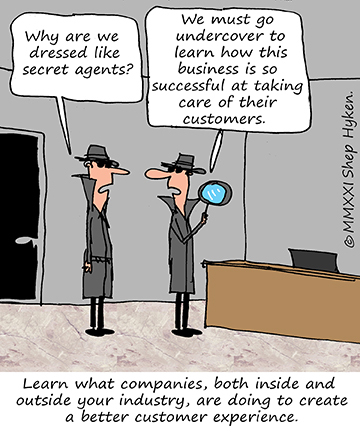 Many companies think they have to compare themselves to their competition. They want to know what the competition is doing that they are not. And when they figure it out, you know what they do? They copy them.
Many companies think they have to compare themselves to their competition. They want to know what the competition is doing that they are not. And when they figure it out, you know what they do? They copy them.
It’s not a bad idea to do that, but it’s not the best idea either. If all you do is compare yourself to your competitors, you may be missing your best opportunities to create the best experience for your customers.
In my newest book, I’ll Be Back: How to Get Customers to Come Back Again and Again, I cover a six-step process to getting your customers to say, “I’ll be back.” I’m going to summarize the process here. It’s not complicated. It’s actually pretty simple, but that doesn’t mean it’s easy. So let’s jump right into it.
Start by calling a meeting. In all, it will probably take at least two or three meetings. Leadership should be there along with other employees with varied responsibilities, from sales, support, finance, and more.
Step One: Ask yourself and the team, “Why should people do business with us?” Answers like, “We have great customer service” are too vague and also something the competition is likely to say. Get specific and think of what you offer that makes you unique.
Step Two: Check out the competition. What do they do that you don’t? Is this something you could be doing? Look for ways they differentiate themselves from what you do.
Step Three: Keep pace. If you discover things that the competition is doing that you’re not, and you decide you want to do something similar, don’t just copy their ideas. Give them a twist and make them your own. If you copy them, you’ll be just like them. And if all you are is a copy of the competition, you are a commodity.
Step Four: Move beyond your industry. Ask the team, “What companies, not including the competitors, do you like doing business with the most, and why?” Any type of company counts small, big, recognizable brands, and more. List reasons you like them and get ready for the next step.
Step Five: Borrow from the best. Looking at the reasons you like the companies listed in Step Four, make note of what these companies do that you don’t, but could. This is a powerful way to create even more distance from your competition.
Step Six: Revisit your value proposition. After you’ve built the ideas in Step Five into your customer experience, go back to the question you started with in Step One: “Why should people do business with us?” You should have some new answers. Even better answers will help you create a better customer experience.
Repeat customers are gold. Loyal customers are sacred. Do it right and your customers will come back again and again. Put this six-step process into action, along with other ideas, strategies, and tactics from the book. This is exactly what it takes to get your customers to say, I’ll Be Back!
Shep Hyken is a customer service expert, keynote speaker, and New York Times, bestselling business author. For information, contact 314-692-2200 or www.hyken.com. For information on The Customer Focus customer service training programs, go to www.thecustomerfocus.com. Follow on Twitter: @Hyken
customer service training programs, go to www.thecustomerfocus.com. Follow on Twitter: @Hyken
(Copyright © MMXXI, Shep Hyken)
The post Here’s How to Get Your Customers to Say, “I’ll Be Back!” appeared first on Shep Hyken.
April 13, 2021
Amazing Business Radio: Ali Rayl
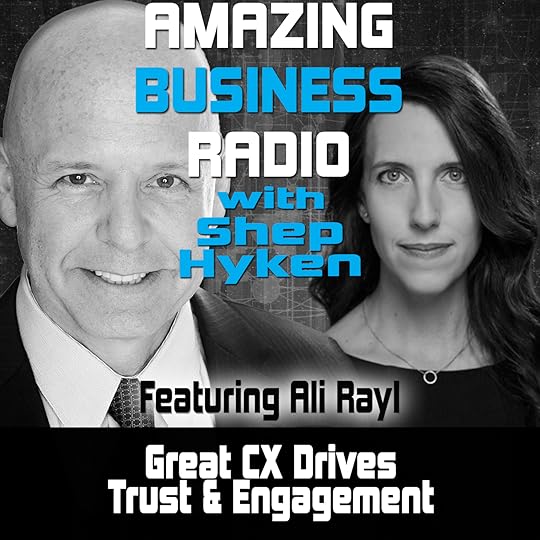 Great CX Drives Trust & Engagement
Great CX Drives Trust & EngagementHow Customer Support Tools Can Impact Your Internal and External Customers
Shep Hyken interviews Ali Ray, VP of Customer Experience at Slack. They discuss how customer support tools can positively impact the customer experience.






 Top Takeaways:Slack is an online customer support tool that brings all the people who have the customer at the center of their work together. Slack provides a platform where users (both internal and external customers) can talk about customer challenges and solve customer problems together.As long as your team understands what’s important and they have access to all the information that they need to do their job successfully, you’ll start to see alignment in your company.Everybody in your company, regardless of their responsibilities, should be on the phone or listening to phone conversations with customers.Great customer experiences drive engagement, trust, and impact the growth and revenue of your business.Don’t just resolve your customers’ issues. Strive to restore the customer’s confidence in your business to a level where they want to come back and ideally recommend you.Quotes:
Top Takeaways:Slack is an online customer support tool that brings all the people who have the customer at the center of their work together. Slack provides a platform where users (both internal and external customers) can talk about customer challenges and solve customer problems together.As long as your team understands what’s important and they have access to all the information that they need to do their job successfully, you’ll start to see alignment in your company.Everybody in your company, regardless of their responsibilities, should be on the phone or listening to phone conversations with customers.Great customer experiences drive engagement, trust, and impact the growth and revenue of your business.Don’t just resolve your customers’ issues. Strive to restore the customer’s confidence in your business to a level where they want to come back and ideally recommend you.Quotes:“You do not get recommendations if your customers do not trust you. Make your business worthy of recommendations.”
“People make smart decisions when they know the direction that they need to go in, along with the information to execute those decisions independently.”
“Broadly accessible communication channels help your business to be more agile by putting all the knowledge that people need to be successful, in their hands.”
About:Ali Rayl is the Vice President of Customer Experience at Slack, responsible for making the working lives of Slack’s millions of users simpler and more productive. She joined Slack during its and has cultivated a culture of customer “love” for the past eight years.
Shep Hyken is a customer service and experience expert, New York Times bestselling author, award-winning keynote speaker, and your host of Amazing Business Radio.
This episode of Amazing Business Radio with Shep Hyken answers the following questions … and more:
What is Slack?How do you get customers to recommend your business?Why is communication with customers important?How do you restore confidence with your customer after a problem?How can communication channels help your business?The post Amazing Business Radio: Ali Rayl appeared first on Shep Hyken.
April 12, 2021
5 Top Customer Service Articles For the Week of April 12, 2021
Each week I read a number of customer service and customer experience articles from various resources. Here are my top five picks from last week. I have added my comment about each article and would like to hear what you think too.
Overpromise by Josh Linkner
(Josh Linkner) Put yourself out there in a big, bold, defiant way. Reach for the solutions for which you lack full confidence you can deliver with little effort, but that will delight your customers or colleagues if you reach.
My comment: I’ve written about the concept of UPOD, which is “Under Promise and Over Deliver.” It’s a great concept as long as the “under promise” part is not such a low bar that the customer is unimpressed. Then there is the concept of “Over Promise and Over Deliver.” My friend Josh Linkner, who has a new book coming out next month titled Big Little Breakthroughs, takes an innovative look at this concept. When you read it, consider how little breakthroughs can enhance the customer experience.
How to Use CX as a Competitive Advantage During Retail Disruption by Russell Haswell
(CMSWire) Digital has become the epicenter of activity and the disruption is leading to an unprecedented opportunity to use customer experience as a competitive advantage.
My comment: I was intrigued with this article, which lists five ways to use customer experience to a competitive advantage, because of the first tip: All customers are new customers. Interesting idea. Consider that COVID has forced many of us to change the way we do business. So it stands to reason that the experience, for even our most loyal customers, may have changed. Even though this is retail-focused, these ideas should prove thought-provoking for any type of business.
At Least Grumpy Old Guys Know What Great Customer Service Is by Steve DiGioia
(Steve DiGioia) We should immediately stop accepting anything less than the best. Demand it in ourselves and of the employees we work with or supervise.
My comment: In my upcoming Achieving Customer Amazement survey I ask the question, “Do you older people provide better customer service than young people, or vice-versa?” We’ll have to wait for the survey results to come back, but in the meantime, here’s an article that argues that the older generation, specifically “Grumpy Old Men” (as in the movie starring Walter Matthau and Jack Lemmon), may have the edge.
5 Ways to Enhance Customer Experience at a Small Business by Daria Brown
(SWAAY) Here are a few low-overhead ways to enhance customer experience.
My comment: Just because the title has “Small Business” in it, doesn’t mean that the largest businesses can’t take advantage of these five tips. I doubt you’ll disagree with anything here. You may call it common sense. Still, it’s a good reminder of some basics that will drive repeat business.
11 Effective Ways to Turn Your Customers Into Loyal Product Advocates by Rolling Stone Culture Council
(Rolling Stone) 11 members of Rolling Stone Culture Council explain a few strategies that have helped them create true product advocates and why they’ve been so effective for their businesses.
My comment: Rolling Stone (Yes, that Rolling Stone – now online) has the Rolling Stone Culture Council, and eleven of their council members have shared their best customer loyalty tips. You’ll find plenty of thoughts from a variety of businesses and industries including cannabis, billboard marketing companies, the movie industry, and more.
Shep Hyken is a customer service expert, professional speaker, and New York Times bestselling business author. For information on The Customer Focus customer service training programs go to www.TheCustomerFocus.com. Follow on Twitter: @Hyken
customer service training programs go to www.TheCustomerFocus.com. Follow on Twitter: @Hyken
The post 5 Top Customer Service Articles For the Week of April 12, 2021 appeared first on Shep Hyken.
April 9, 2021
Guest Post: Customer Service Telephone Skills – Master Your Art of Conversation with Clients
This week we feature an article by Vihar Naik a writer for CallHippo, a cloud-based Intelligent virtual phone system for business & enterprise. He writes about skills everyone should have to communicate effectively with clients.
Did you know 90% of Americans consider customer service as the key factor when deciding whether to do business with a company? If you’re a customer-focused organization, you need to prioritize customer service.
Let’s look at some essential skills every customer executive needs to master the art of conversation with clients.
Customer Service Telephone Skills to MasterGood-quality customer service goes beyond the telephony software or CRM system you use. Here are some customer service telephone skills every customer support executive should possess.
Greet Your Customer Politely and ProfessionallyThe first impression is the last. If you can make the customer develop a liking for you in the first five seconds of the call, it’ll greatly influence the overall interaction.
Moreover, most customers who call customer service are already having a bad day. Greeting them with a negative, cold, and unprofessional tone will add fuel to the fire.
Ensure that your greeting is full of warmth. When you pick up the call, modulate your tune as you’d talk to a close friend of yours. Also, don’t just say, “Hello.” Start the conversation with something like, “Good morning. Thanks for calling XYZ. How may I assist you?”
Answer the Phone ImmediatelyTime plays a vital role in customer service. When a customer calls you, she expects you to pick up within two rings. Anything more than that can result in the buildup of frustration.
Of course, there can be instances where you might not be able to answer the phone promptly. And it’s fine. But make sure that the majority of your calls are picked up on the second or third ring.
However, it’s a best practice to let the phone ring for a second or two. If you pick up the call instantaneously, the customer won’t hear the ring at all. This will create confusion as to whether the call is connected or not.
So, when a customer calls, let it ring for a second and then answer it.
Find a Quiet EnvironmentA noisy environment can ruin your interaction with the customers. The last thing you want is your already unhappy customers getting furious because they had to repeat their problem a dozen times.
Ideally, call center organizations take care of the sound problem. They ensure each agent gets a quiet and peaceful environment to interact with the customer.
But if there’s noise around you, move to a quieter place. Most modern-day VOIP Providers offer cloud-accessibility, enabling you to run your call center operations from any device. You can install the system on your smartphone and move to a less noisy place.
Be Sincere and GenuineRemember the polite and professional greeting we talked about earlier? Your politeness and professionalism shouldn’t be confined to the greeting. To provide a superior customer experience, you need to be since and genuine throughout the conversation.
Now, how can you achieve that? First, ditch the scripts. If you’re a new customer support rep, your organization will certainly ask you to follow a script. But guess what? Reading from a script makes you sound like a robot.
When customers call the support center, they expect to engage in meaningful conversations and find resolutions to their problems. By no means do they want to talk to someone who’s reading a script?
Second, have empathy and be humble. Sometimes, you’ll get calls for tiny problems – something a toddler would’ve fixed. You might come across aggressive customers. Or, in some cases, you may find less intelligent customers who won’t understand what you say.
In any case, don’t lose your patience. Be polite and keep on talking to them with sincerity and respect.
Address Customers with Their NamesWant to know a secret? When customers call the support center, they’re looking for a guide. They’re neither looking for a hero nor a follower. They want someone who understands and respects them but has authority.
In simple terms, don’t address your customers as “Sir.” When you address them this way, you make them think that you follow them. when talking to them. This will send a message to the customer that they’re talking to someone equal who can solve their problem.
However, don’t abuse the name. It will sound weird and send a message that you’re trying to oppress the customer. Include the name naturally in the conversation so that the customer feels as if he’s talking to a friend.
Don’t Disconnect Until the Customer is SatisfiedEnding the conversation on the right note is critical for a positive customer experience. Let the customer talk and answer all their questions. Once the conversation comes to an end, confirm if you can help them in any other way.
Problems arise when you’re not able to resolve the query. There will be times when you won’t be able to resolve a customer’s problem. While the reasons can vary, you should ensure that you end the call on a positive note.
To do so, assure your customers that their issues will be resolved. An effective way to do this is by escalating the complaint and giving a confirmation message to the customer. You can also tell them that the company will call them back soon and there’s nothing to worry about.
Wrapping UpGone are the days when customers cared only about the product quality and reputation of the company. Customer experience and service quality have become the pillars and business success, and companies need to adapt.
By training your reps and helping them develop the skills mentioned above, you can enhance your customer support efforts.
So, which of these skills mentioned above do you think is the most crucial?
Vihar Naik loves to write about Virtual phone numbers, Contact center solutions and communication skills, and more. You can find him on Linkedin.
F
 or more articles from Shep Hyken and his guest contributors go to customerserviceblog.com.
or more articles from Shep Hyken and his guest contributors go to customerserviceblog.com.
Read Shep’s latest Forbes article: How To Create Customer Love In The Digital World
The post Guest Post: Customer Service Telephone Skills – Master Your Art of Conversation with Clients appeared first on Shep Hyken.
April 7, 2021
Avoid Customer Confusion
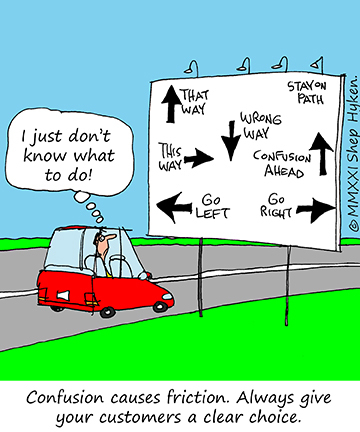 Today’s customers are smarter than ever. They know how to buy. The digital/online world has given customers the power to research products, read reviews, and compare prices.
Today’s customers are smarter than ever. They know how to buy. The digital/online world has given customers the power to research products, read reviews, and compare prices.
Often, customers have made up their minds about what they are going to buy before they ever leave their home or office. They are armed with knowledge and information, ready to talk to the salesperson and buy what they came for. Often, that works out well for everyone. The smarter customer can save the salesperson time and effort. That gives a smart salesperson the opportunity to confirm the customer is making a good decision, ethically upsell or cross-sell, and most importantly, build the relationship for the next time the customer needs whatever the company sells.
So, back to the idea that customers are smarter and know what they want. What happens if the customer finds a price online and then goes into a brick-and-mortar store to buy it? Does the store match the price? Sometimes. But what happens if the online price is from the brand’s own website, then the customer goes to the store and finds a higher price, and the store won’t match the online price? That actually happened … to me.
I was buying a ping-pong table. I researched online and found one I wanted from a store’s website. I drove to their brick-and-mortar location, just three miles from my home, and they refused to match the price, which was substantially lower online. The salesman said, “Sorry, they are actually a different company.” Really? Same name, same logo, same products, but different prices; and I couldn’t get them to budge. So, I went home and bought it online, with free shipping as well.
I just heard from Lisa Yetman, one of our Shepard Letter subscribers, with a similar example, but with a better outcome. She works at Barnes and Noble and she wrote: Up until about two years ago, the stores and online retail site were two different entities. Then it all changed a bit when we were given the green light to do price matching between these two retail departments. Now, if someone comes in to buy a book they saw on our website, we can access the online price through our register. If the price is lower, we are able to save our Guests some money.
I get why there are price differences. In my research about BN, I read a good explanation about why the prices might be different, and it had to do with the lower overhead of an online business. But even with that explanation, it’s hard to get a customer to understand that just because a company puts .com behind its name, it should be a different experience. Shop online at Best-Buy, Walmart, and other major retailers. They give you the option of picking an item up at the nearest store, having an online item shipped to the store, or having the item shipped directly to your home. And the prices are the same.
While the examples I shared were about pricing, there are many other ways to confuse customers. My point is that we should look at our processes, our products, and more. The best way to frustrate the customer is with inconsistency in any area of your business. Confused customers will never be loyal. Confusion erodes trust. A lack of trust will cost you sales. A lack of trust costs you repeat business and will never earn you loyalty. Avoid uncertainty. Avoid inconsistencies. Avoid confusion!
Shep Hyken is a customer service expert, keynote speaker, and New York Times, bestselling business author. For information, contact 314-692-2200 or www.hyken.com. For information on The Customer Focus customer service training programs, go to www.thecustomerfocus.com. Follow on Twitter: @Hyken
customer service training programs, go to www.thecustomerfocus.com. Follow on Twitter: @Hyken
(Copyright © MMXXI, Shep Hyken)
The post Avoid Customer Confusion appeared first on Shep Hyken.





